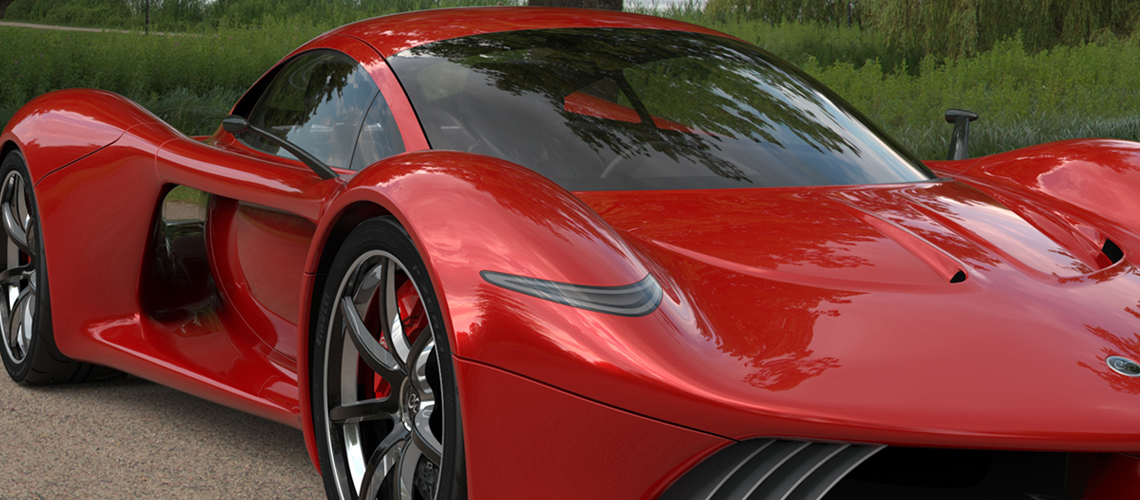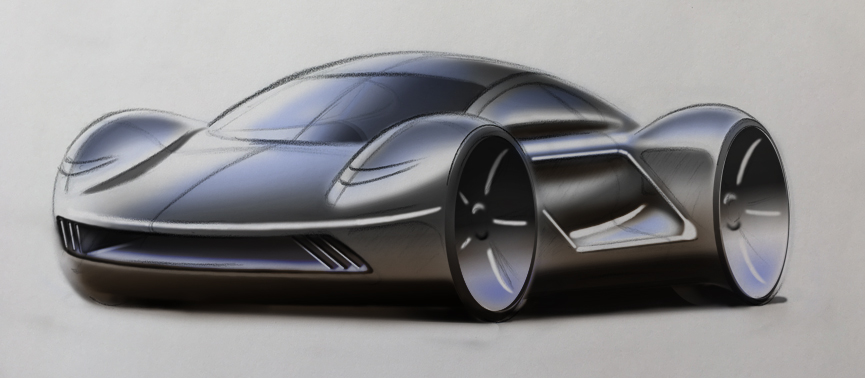


In a designer’s career there are often projects where the stars didn’t quite line up and you’re left with a ‘What if…’ feeling. One project that stands out for us is during the 1990’s and the company was Spectre cars.
Automotive enthusiasts may recall the Spectre R42 supercar – A supercar with excellent dynamic ability, but unable to compete aesthetically with those exotic foreign imports that we all know and adore. Car magazine described the R42 as ‘an example of how difficult it is to play Ferrari and Lamborghini’s game without players like Pininfarina and Gandini’.
When the company went into receivership in the mid 90’s it looked like it was game over – but the company was saved from an untimely demise by a new investment team led by Anders Hildebrand and they began to consider evolving the car into a new design. They asked legendary designer Peter Stevens (of McLaren F1, Lotus Esprit, Jaguar XJR15 etc fame) to assist with some ideas for this design evolution, but his work schedule was too full for their tight development window. Peter recommended our very own Ian Webster for the job and it was a challenge that Ian relished.
Ian created some design concepts for the project that would enable the revised Spectre to compete with the big boys in the looks department. The Spectre team took the ideas and evolved them in their own inimitable way into the Spectre R45. The results were very different from what Ian intended, but we remain impressed by anyone who can develop a design to production. Anders was a real showman about it all and managed to tempt racing supremo Derek Bell on board for the performance development; ‘Q’ from the James Bond movies was at the launch and he even managed to get the R42 a starring role in the movie RPM.
Sadly, it wasn’t enough and Spectre Supersports Ltd ran out of money, folding in 1998. It’s legacy for us, is as another example of British engineering ability that almost gets to play with the big boys, but is ultimately let down by insufficient build quality and as Nic Cackett from Autocar so aptly puts it (when referring to the similarly flawed Noble M600) being incumbered with ‘cottage-industry styling’.
A year or so later Spectre was resurrected yet again and Ian was contacted to discuss the potential of creating a new design - this time from concept to production. The new team were very likable and enthusiastic but it was clear to Ian that there was going to be a problem with funding, so he declined the invite and wished them well.
So then, we clearly have a soft spot for this little underdog company and maybe it’s time to go on a flight of fancy and imagine a modern Spectre EV supercar with looks that could match the performance.
The sight of a supercar passing-by can bring out the inner child in any auto enthusiast. There will often be an involuntary 'Ooooo!' or 'Aaaaaa!' if one passes you by unawares. It's low, it's fast and it's seductive - and you just hope that one day you can have one of these exotic creatures for yourself...
The brief was to use a fully electric drivetrain because it's proving to be the power source of the immediate future, even if it may be superseded in the long term.
We'll let Ian explain some of his reasoning about the design - 'The more compact power arrangement of the EV has resulted in a chance to play with the forms around the drivetrain more than normal and explore the use of negative space to a greater degree. The outer surfaces of the car are intentionally classic supercar in their proportions - but when look at that side cut-out you begin to realize that the air is drawn through the car and around a sculptured cabin form, before it leaves out of the back of the car. The design beckons you to look around the car to see where the negative space takes your eye. In less pompous terms, it means that you can be knelt down at the front three-quarter view and be able to see through the car and tell your friend stood behind the car that his flies are undone...
At this point it's worth noting that this design was created before the Lotus Evija arrived on the scene - showing a similar thought of passing the air through the car, (although it's only right to mention the impressive Ford GT, which has clearly been playing this game for some time).
The seating layout is that of a central driving position, with two off-set seats behind (similar to the old McLaren F1) for all the same reasons that McLaren choose it in the first place - We just think it’s the ideal layout for a supercar.
As the car evolved from the initial renderings, the form became more organic and sculptural and we think it gives a distinctly modern flavour to the classic supercar proportions. We’re very pleased with the end result and we think the Spectre Meson supercar provides an interesting glimpse into what could have been…
